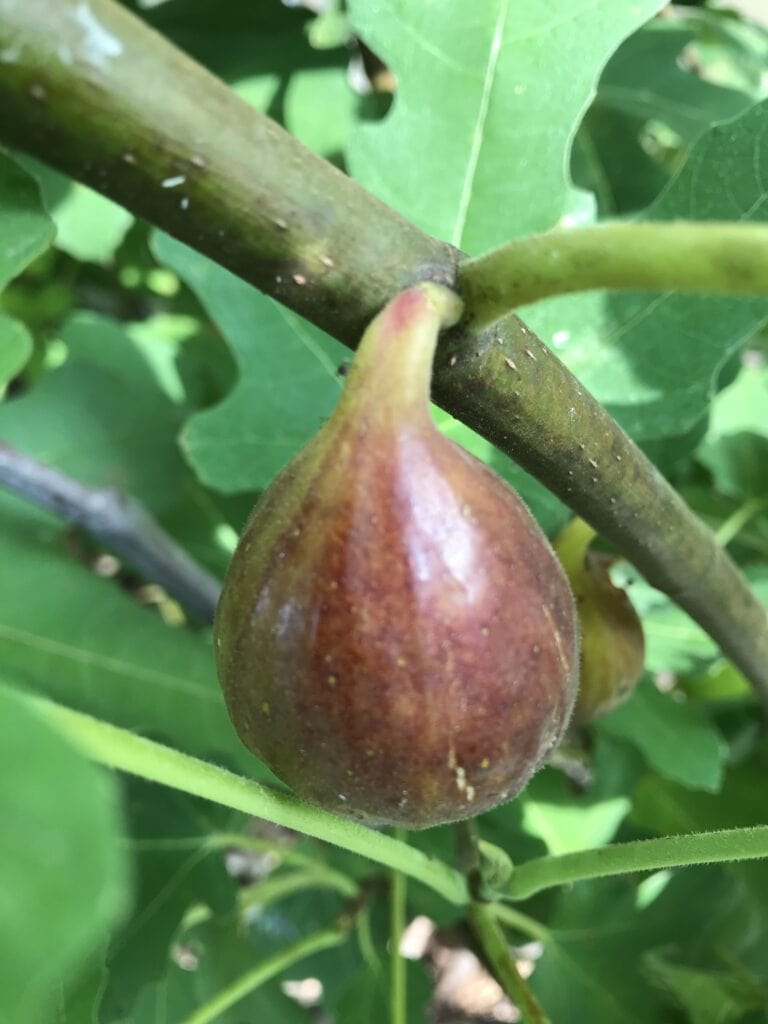This post may contain affiliate links. Probably doesn’t, but it might. It doesn’t cost you anything extra but if you use these links to buy something, we may earn a commission.
In the heart of our farm’s evolution lies a tale of sweetness and tradition, embodied by the humble fig tree. What started as an experiment in diversifying our orchard has blossomed into a cherished tradition, deeply rooted in our farming ethos. Join us as we share our journey of cultivating fig trees, from the first saplings to a bountiful grove, and how these ancient fruits have woven themselves into the very fabric of our farm’s story.
Table of Contents
From the Fig Chronicles
Once upon a time, a long time ago, back when there were classified ads in the newspaper and people read those ads, my mother saw an ad for fig trees in Wilmington. “Hmmm,” Elaine thought. “If he can grow figs in Wilmington, so can I.” Definitely a competitive streak in the family.
Elaine and my youngest brother, Matt, drove to Wilmington to find this gentleman (using a map and my mother’s knowledge of Wilmington) who had fig trees growing in his backyard. “Here they are,” he said. “Which one would you like?” They picked out a tree, dug it up, and brought it back. This happened 1978 or so. This fig tree is still with us, a variety called Celeste, small, very sweet, and delicious.
A Little History of Fig Trees and How They Came to North America
And that was the first fig tree. My mother, of course, is not alone in loving figs. Figs have commanded a dedication and following that borders on the cult edge of devotion. Fig fossils are dated to about 9400 BCE in the Jordan River valley—about 1000 years before evidence of wheat or barley cultivation, and the first evidence of agriculture. Highly prized as a delicacy and honored in many religious traditions as an important symbol of peace, fertility, and prosperity, figs occupy a special place in our hearts.
Fig trees followed the routes of exploration from the middle East, spreading throughout Greece (Aristotle and Theophrastus both weighed in on figs) to Turkey (world’s largest producer of figs today), all of the Roman Empire, Afghanistan, Portugal, India, China, and England. And the Spanish first brought figs to California in 1520. Not only did people take fig trees with them to plant in whichever newly conquered or trading area, they were compelled to tell everyone that they did.
The Italians in the 19th century get much of the credit for bringing many varieties of figs to the United States, as they brought their beloved trees when they immigrated. We were the beneficiary of this trend. An older Italian gentleman saw my mother’s precious figs in the farm market; “Did you grow these?” “Yes, I did,” was the proud answer. “Well, I have figs that are much larger and very good.” A brief moment as they eyed each other. They agreed to trade cuttings. And that is how our second tree came to us, about 1982. Variety is Brown Turkey, still with us and growing well. Apparently, fig trees can live to be 100 years old or so; we will find out.
Growing Figs in Colder Climates
The challenge of growing figs in northern Delaware is winter. Figs grow best with mild winters—no snow, no freezing. The tree survives, but then it dies back to the ground, and the new growth does not have time to produce and ripen the figs before the nights start cooling off in September. We have spent many years dumping leaves on the trees, wrapping them, and trying to protect them from freezing temperatures and harsh winds.
Finally, we came up with our fig tunnel. We took cuttings from our fig trees and planted them all in a row, then covered them with a double layer of greenhouse sheeting. No additional heat, but just enough protection that the trees start leafing out early in spring and start producing an abundance of figs in the summer. Success!
If there has been enough winter protection and if the winter was sufficiently mild, we can get an early crop of figs in June, called a Breba crop. We cannot count on an early crop, but we do count on the main crop. Most of the figs ripen in September and October with the abundance of the main crop.
It takes about 90 days from the time you first spot a little green fig on the branch until it is soft enough to harvest.
Is a Fig a Fruit?
We call figs fruit, but technically they are “syconium” and the flowers grow inside of the covering. Each little seed of a fig is part of its flower. Figs can have skin that is green, brown, purplish-black, black, or white. There are hundreds of varieties. Figs are full of calcium, iron, and fiber. Figs have been used medicinally as a diuretic or laxative. If you eat too many, look out!
But above all, figs are delicious. Sweet, juicy, wonderful as fresh eating, added to salads, grilled, paired with cheese, made into preserves. I think I am going to do something fancy with these beautiful figs, and then I wind up popping it in my mouth. Yep, still scrumptious. Maybe I need to check another one…
Finding Fresh Figs
If you have not tried fresh figs, you owe yourself that treat. They are amazing. Finding fresh figs can be challenging, as they are quite fragile and do not ship well.
Some places that may have fresh figs: specialty produce markets, farmers markets, and local growers. Your best option is to find the grower, either at a farmers market or at the local farm. There you will be able to have the figs as they are harvested. Since figs are at their sweetest when they are soft, they cannot bear much handling and must be treated very gently. Find out when the season for figs is in your area so that you do not miss this delectable treat!
Conclusion
As the seasons turn and our fig trees continue to thrive, their presence on our farm has become more than just a cultivation choice—it’s a symbol of our commitment to sustainable, meaningful farming practices. These trees, with their ancient roots and timeless fruit, remind us daily of the beauty and abundance that nature provides. Each fig harvested is not just a fruit, but a testament to our dedication to honoring the land and sharing its bounty with our community. The love we’ve poured into nurturing these trees has been repaid tenfold, not just in fruit, but in the joy and connection they bring to all who visit our farm.
Thank you to my mother for teaching us to love figs and showing us that trying to grow a new thing is good for us!
If you are close to us in Wilmington, Delaware, we have fresh figs starting the end of August and through most of October. If not, please find a local farm near you that is growing figs. Thank you for your support of family farms!
~ Ruth
Additional resources
https://www.chelseagreen.com/2022/10-fascinating-fig-facts/
https://gms.ctahr.hawaii.edu/gs/handler/getmedia.ashx?moid=3044&dt=3&g=12






